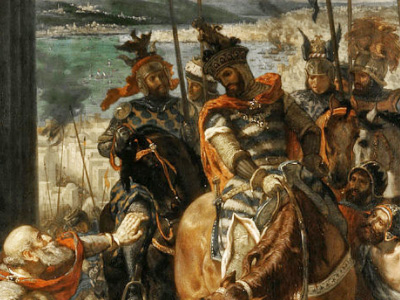Fourth Crusade (1202–04)
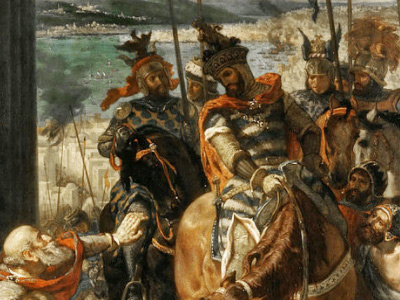
Outcome
Only a relatively small number of the members of the Fourth Crusade finally reached their originally intended goal of the Holy Land. Research indicates that about a tenth of the knights who had taken the cross in Flanders arrived to reinforce the remaining Christian states there, plus about half of those from the Île-de-France. During the ensuing half century the unstable Latin Empire siphoned off much of Europe's crusading energy. The legacy of the Fourth Crusade was the deep sense of betrayal felt by the Greek Christians. With the events of 1204, the schism between the Churches in the East and West was not just complete but also solidified.
As an epilogue to the event, Pope Innocent III, the man who had unintentionally launched the ill-fated expedition, spoke against the crusaders thus:
How, indeed, will the church of the Greeks, no matter how severely she is beset with afflictions and persecutions, return into ecclesiastical union and to a devotion for the Apostolic See, when she has seen in the Latins only an example of perdition and the works of darkness, so that she now, and with reason, detests the Latins more than dogs? As for those who were supposed to be seeking the ends of Jesus Christ, not their own ends, who made their swords, which they were supposed to use against the pagans, drip with Christian blood, they have spared neither religion, nor age, nor sex. They have committed incest, adultery, and fornication before the eyes of men. They have exposed both matrons and virgins, even those dedicated to God, to the sordid lusts of boys. Not satisfied with breaking open the imperial treasury and plundering the goods of princes and lesser men, they also laid their hands on the treasures of the churches and, what is more serious, on their very possessions. They have even ripped silver plates from the altars and have hacked them to pieces among themselves. They violated the holy places and have carried off crosses and relics.
Nevertheless, the Pope accepted the new situation. When the crusaders took some of the piles of money, jewels, and gold that they had captured in the sack of Constantinople back to Rome, Innocent III accepted the stolen items. Furthermore, at the Fourth Council of the Lateran the Pope welcomed and recognized to it western (Catholic) prelates from Sees established in the conquered lands – thus recognizing their legitimacy over formerly Orthodox areas.
The Latin Empire was soon faced with a number of enemies. Besides the individual Byzantine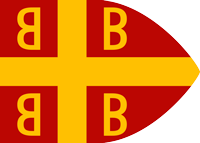 The Byzantine Empire, also referred to as the Eastern Roman Empire or Byzantium, was the continuation of the Roman Empire primarily in its eastern provinces during Late Antiquity and the Middle Ages, when its capital city was Constantinople. It survived the fragmentation and fall of the Western Roman Empire in the 5th century AD and continued to exist for an additional thousand years until the fall of Constantinople to the Ottoman Empire in 1453. Greek states in Epirus and Nicaea, there were also the Seljuk Sultanate and the Bulgarian Empire. The Greek states fought for supremacy against both the Latins and each other.
The Byzantine Empire, also referred to as the Eastern Roman Empire or Byzantium, was the continuation of the Roman Empire primarily in its eastern provinces during Late Antiquity and the Middle Ages, when its capital city was Constantinople. It survived the fragmentation and fall of the Western Roman Empire in the 5th century AD and continued to exist for an additional thousand years until the fall of Constantinople to the Ottoman Empire in 1453. Greek states in Epirus and Nicaea, there were also the Seljuk Sultanate and the Bulgarian Empire. The Greek states fought for supremacy against both the Latins and each other.
Several of the major Greek and Latin protagonists in the event died or were killed in the years following the fall of the city. The betrayal and blinding of Murtzuphlus by Alexios III led to his capture by the Latins and his execution in 1205. Not long after, Alexios III was captured by Boniface and sent to exile in Southern Italy. He died in Nicaea in 1211. In 1205, Kaloyan of Bulgaria crushed the Latin Crusaders with his Cuman light cavalry. On 14 April 1205, one year after the conquest of the city, Emperor Baldwin was decisively defeated and captured at the Battle of Adrianople by the Bulgarians. In 1205 or 1206, the Bulgarian Emperor Kaloyan mutilated him and left him to die, while others suggest he was kept captive in the famous Baldwin's Tower in the Bulgarian capital Veliko Turnovo, where he died under unknown circumstances. The Venetian Doge Dandolo died in May 1205. On 4 September 1207, the Bulgarians killed Boniface in an ambush. He was succeeded by his infant son Demetrius of Montferrat, who ruled until he reached adulthood but was eventually defeated by Theodore I Doukas, the despot of Epirus and a relative of Murtzuphlus. The Kingdom of Thessalonica was restored to Byzantine rule in 1224.
Various Latin-French lordships throughout Greece – in particular, the Duchy of Athens and the principality of the Morea – provided cultural contacts with western Europe and promoted the study of Greek. There was also a French cultural work, notably the production of a collection of laws, the Assises de Romanie. The Chronicle of Morea appeared in both French and Greek (and later Italian and Aragonese) versions. Impressive remains of crusader castles and Gothic churches can still be seen in Greece. Nevertheless, the Latin Empire always rested on shaky foundations. Constantinople was re-captured by the Nicaean Greeks under Michael VIII Palaeologos in 1261, and commerce with Venice was re-established.
During the middle of the 15th century, the Latin Church (Roman Catholic Church) tried to organize a new crusade aimed at restoring the Eastern Roman or Byzantine Empire, which was gradually being torn down by the advancing Ottoman Turks. The attempt failed, however, as the vast majority of Greek civilians and a growing part of their clergy refused to recognize and accept the short-lived near-union of the Churches of East and West signed at the Council of Florence and Ferrara by the Ecumenical patriarch Joseph II of Constantinople. The Greek population, reacting to the Latin conquest, believed that the Byzantine civilization that revolved around the Orthodox faith would be more secure under Ottoman Islamic rule. Overall, religious-observant Greeks preferred to sacrifice their political freedom and political independence in order to preserve their faith's traditions and rituals in separation from the Roman See.
In the late 14th and early 15th centuries, "crusades" on a limited scale were organized by the Kingdoms of Hungary, Poland, Wallachia, and Serbia. These were not the traditional expeditions aimed at the recovery of Jerusalem but rather defensive campaigns intended to prevent further expansion to the west by the Ottoman Empire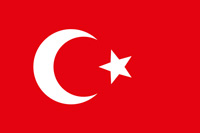 The Ottoman Empire, also known as the Turkish Empire, was an empire that controlled much of Southeast Europe, Western Asia, and Northern Africa between the 14th and early 20th centuries. The Ottomans ended the Byzantine Empire with the conquest of Constantinople in 1453. The Ottoman Empire's defeat and the occupation of part of its territory by the Allied Powers in the aftermath of World War I resulted in its partitioning and the loss of its Middle Eastern territories.. During the Ottoman siege of Constantinople in 1453, up to 2,000 Venetian and Genoese volunteers formed part of the approximately 9,000 defenders of the city.
The Ottoman Empire, also known as the Turkish Empire, was an empire that controlled much of Southeast Europe, Western Asia, and Northern Africa between the 14th and early 20th centuries. The Ottomans ended the Byzantine Empire with the conquest of Constantinople in 1453. The Ottoman Empire's defeat and the occupation of part of its territory by the Allied Powers in the aftermath of World War I resulted in its partitioning and the loss of its Middle Eastern territories.. During the Ottoman siege of Constantinople in 1453, up to 2,000 Venetian and Genoese volunteers formed part of the approximately 9,000 defenders of the city.
HISTORY
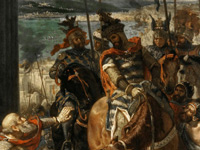
RESOURCES
This article uses material from the Wikipedia article "Fourth Crusade (1202–04)", which is released under the Creative Commons Attribution-Share-Alike License 3.0.
© Stories Preschool. All Rights Reserved.
